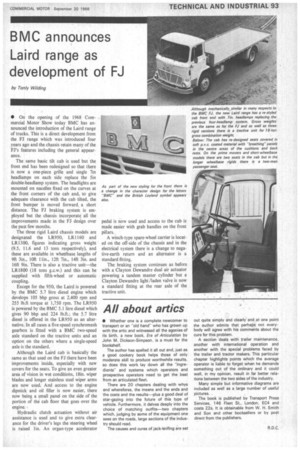BMC announces Laird range as development of FJ
Page 97

If you've noticed an error in this article please click here to report it so we can fix it.
• On the opening of the 1968 Commercial Motor Show today BMC has announced the introduction of the Laird range of trucks. This is a direct development from the RI range which was introduced four years ago and the chassis retain many of the El's features including the general appearance.
The same basic tilt cab is used but the front end has been redesigned so that there is now a one-piece grille and single Tin headlamps on each side replace the 5in double-headlamp system. The headlights are mounted on nacelles fixed on the curves at the front corners of the cab and, to give adequate clearance with the cab tilted, the front bumper is moved forward a short distance. The FJ braking system is employed but the chassis incorporate all the improvements made in the RI design over the past few months.
The three rigid Laird chassis models are designated the LR950, LR1160 and LR1300, figures indicating gross weight (9.5, 1L6 and 13 tons respectively), and these are available in wheelbase lengths of 9ft 3in., 10ft Elm., 12ft 7n., 14ft 3in. and 16ft 9in. There is also a tractive unit—the LRI800 (18 tons g.c.w.) and this can be supplied with fifth-wheel or automatic coupling.
Except for the 950, the Laird is powered by the BMC 5.7 litre diesel engine which develops 105 bhp gross at 2,400 rpm and 255 lb.ft torque at 1,750 rpm. The LR950 is powered by the BMC 5.1 litre diesel which gives 90 bhp and 224 lb.ft.; the 5.7 litre diesel is offered in the LR950 as an alternative. In all cases a five-speed synchromesh gearbox is fitted with a BMC two-speed axle standard on the tractive units and an option on the others where a single-speed axle is the standard.
Although the Laird cab is basically the same as that used on the FJ there have been improvements inside, especially with new covers for the seats. To give an even greater area of vision in wet conditions, 18in. wiper blades and longer stainless steel wiper arms are now used. And access to the engine dipstick and oil filler is now easier, there now being a small panel on the side of the portion of the cab floor that goes over the engine. \ Hydraulic clutch actuation without air assistance is used and to give extra clearance for the driver's legs the steering wheel is raised lin. An organ-type accelerator pedal is now used and access to the cab is made easier with grab handles on the front pillars..
A winch-type spare-wheel carrier is located on the off-side of the chassis and in the electrical system there is a change to negative-earth return and an alternator is a standard fitting.
The braking system continues as before with a Clayton Dewandre dual air actuator powering a tandem master cylinder but a Clayton Dewandre light /laden valve is now a standard fitting at the rear axle of the tractive unit.


















































































































































































































































































































































































